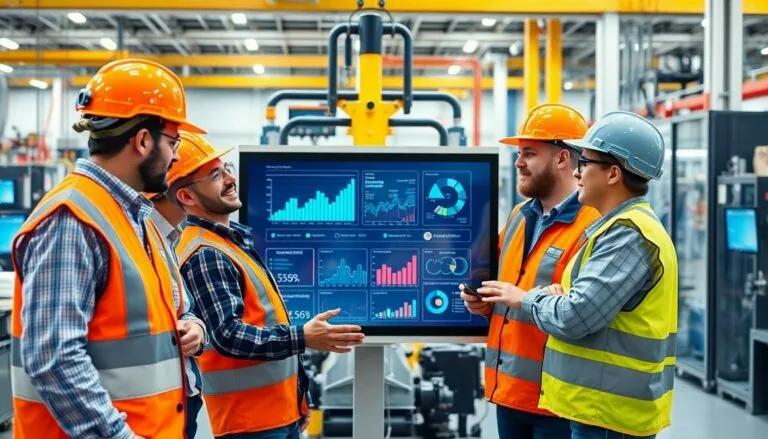Table of Contents
ToggleImagine a world where your morning coffee brews itself while a holographic assistant reminds you of your to-do list, all thanks to the magic of hologram IoT. This isn’t science fiction; it’s the exciting intersection of holography and the Internet of Things. As technology leaps forward, these dazzling 3D images are set to revolutionize how we interact with our devices and environments.
Hologram IoT isn’t just about flashy visuals. It’s about creating smarter, more intuitive experiences that make life easier and a bit more fun. Picture a virtual meeting where colleagues pop up as holograms in your living room or a shopping spree where you can see how clothes fit without ever stepping foot in a store. The future is bright—and holographic! Buckle up, because the ride into this tech wonderland is just getting started.
Overview of Hologram IoT
Hologram IoT merges holography with the Internet of Things, creating immersive digital environments. This technology enables devices to project three-dimensional holograms, enhancing user interaction. Holographic displays facilitate more intuitive management of tasks, including controlling smart home devices or organizing schedules.
Future workplaces may feature virtual meetings where colleagues appear as holograms, fostering collaboration without physical presence. This immersive experience transcends traditional video conferencing, promoting a sense of togetherness.
Retail environments could transform as well. Shoppers might visualize products as holograms, leading to informed purchasing decisions. Trying on virtual clothes or previewing furniture in a living space becomes more feasible, changing how consumers engage with brands.
Healthcare applications present significant opportunities. Surgeons can leverage holograms for 3D visualizations during complex procedures, improving precision and outcomes. Patients might use personal holograms to monitor health metrics, enabling proactive management.
Education also benefits from this technology. Students participate in interactive learning, exploring complex subjects through holographic representations. Science experiments and historical events come to life, enhancing comprehension and retention.
Hologram IoT represents a significant leap forward, promising to revolutionize daily interactions with technology. By combining holographic visuals with connected devices, this approach opens new avenues for communication, productivity, and entertainment. The integration not only improves efficiency but also fosters creativity, paving the way for future innovations in various fields.
Key Features of Hologram IoT

Hologram IoT combines holography with the Internet of Things, showcasing unique features that enhance user interaction and experience.
Scalability
Scalability stands out as a critical feature of Hologram IoT. This technology supports the integration of numerous devices without performance degradation. Businesses benefit by expanding their networks gradually, adding new holographic solutions as needed. Users can manage a range of applications, from smart home setups to extensive industrial systems. Growth opportunities become accessible through scalable solutions, ensuring adaptability across various sectors. Efficient resource management aligns with increased demand while maintaining seamless operation across devices.
Flexibility
Flexibility plays an essential role in Hologram IoT applications. The technology allows for diverse device interactions, accommodating different user needs. Organizations customize holographic experiences to suit specific requirements, whether for remote collaboration or customer engagement. Developers can create tailored applications, enhancing productivity and creativity across industries. As diverse user scenarios arise, the flexibility of Hologram IoT ensures that solutions remain relevant and responsive. This adaptability supports innovation, facilitating creativity across healthcare, education, and retail.
Applications of Hologram IoT
Hologram IoT offers transformative potential across several sectors, enhancing user experiences and operational efficiencies. Its applications create a dynamic interface between technology and users, paving the way for innovative solutions.
Smart Cities
Smart cities benefit from hologram IoT by integrating real-time data with holographic displays. Citizens can interact with holograms to receive information about public transportation, emergency alerts, or local events. Infrastructure monitoring improves as city managers visualize data in three dimensions, enabling efficient resource allocation. Energy management systems feature holographic interfaces that assist in managing consumption more intuitively. Connectivity fosters community engagement, turning local governance into a more interactive experience.
Healthcare
In healthcare, hologram IoT plays a critical role by enhancing surgical procedures with advanced 3D visualizations. Surgeons utilize holographic projections of patient anatomy, allowing for more precise interventions. Patient engagement improves through holographic apps that visualize health metrics, enabling individuals to track wellness progress interactively. Training simulations feature holograms to provide realistic scenarios for medical students, making education more impactful. Consultation experiences benefit by allowing specialists to present holographic health models during remote discussions, improving collaboration.
Retail
Retail environments leverage hologram IoT to transform the shopping experience into a more immersive journey. Shoppers interact with holographic displays to visualize products before purchasing, which aids in informed decisions. Virtual fitting rooms use holography to allow customers to try products on in real-time without physical trials. Marketing initiatives feature holographic advertisements that capture attention, enhancing brand engagement. Checkout processes streamline as holographic interfaces facilitate transactions, making shopping quicker and more convenient.
Benefits of Hologram IoT
Hologram IoT offers numerous advantages that enhance user experiences across different fields. Enhanced interactivity stands out as a primary benefit, allowing users to engage with holographic displays in ways that traditional interfaces cannot match.
In healthcare, surgical teams gain improved precision as holograms provide 3D visualizations during complex procedures. These visual aids lead to better outcomes and increase patient safety. Furthermore, patients monitor their health metrics interactively through holographic interfaces, leading to greater engagement in their health journeys.
Educational settings also reap benefits from Hologram IoT. Students engage in dynamic learning experiences where complex subjects transform into immersive holographic representations. This approach fosters deeper understanding and retention of information.
Retail environments benefit significantly as well. Shoppers experience enhanced purchasing decisions through virtual fitting rooms that display products as holograms. Seamless checkout processes further streamline the shopping experience, encouraging repeat visits.
Additionally, Hologram IoT promotes collaboration in workplaces. Virtual meetings with holographic colleagues facilitate teamwork by bridging geographical gaps. Teams interact as if they’re physically present, leading to more effective communication and creativity.
Scalability remains a key feature. It allows organizations to integrate numerous devices without performance issues, supporting gradual expansions of network capabilities. Flexibility in interactions accommodates diverse user needs, enabling customized holographic experiences for different applications.
Citizen engagement receives a boost in smart cities through Hologram IoT. Real-time data presented in holographic displays improves infrastructure monitoring while enhancing energy management systems. This leads to smarter, more sustainable urban environments.
Overall, Hologram IoT brings transformative potential across healthcare, education, retail, and smart cities, streamlining operations and enriching user experiences.
Challenges and Limitations
Hologram IoT faces several challenges that impact its adoption and effectiveness. High costs associated with technology development and implementation limit accessibility for many organizations. Resources required for creating and maintaining holographic systems can strain budgets, especially for smaller businesses.
Technical limitations also present obstacles. Current hardware may not support the necessary processing power or graphics capabilities to create seamless holographic experiences. Device compatibility issues arise, as various devices might struggle to integrate smoothly with holographic systems.
Additionally, network infrastructure remains a concern. Reliable high-speed internet is crucial for real-time holographic interactions, especially in remote areas where connectivity might be inconsistent. Security risks also accompany the integration of hologram IoT. Data privacy concerns intensify as holographic systems collect and analyze personal information, requiring robust security measures to protect users.
User acceptance poses another challenge. Many individuals may be hesitant to adopt holographic technology due to unfamiliarity or skepticism regarding its practical applications. Training and education are vital to ensure users understand how to interact with and benefit from hologram IoT.
Lastly, regulatory hurdles could impact the growth of hologram IoT. Compliance with existing standards and regulations in different regions may complicate development and deployment. As industries seek to embrace this innovative technology, addressing these challenges will be essential for successful integration and widespread adoption.
The emergence of hologram IoT is set to redefine how individuals interact with technology across various sectors. By merging holography with the Internet of Things, it creates immersive experiences that enhance productivity and engagement. From transforming healthcare with 3D surgical aids to revolutionizing retail with virtual shopping, the possibilities are vast.
Despite the challenges of high costs and technical limitations, the potential benefits far outweigh the hurdles. As technology advances and becomes more accessible, organizations can leverage hologram IoT to innovate and improve user experiences. The future holds exciting prospects for this cutting-edge technology, promising to enrich daily life and foster collaboration in unprecedented ways.







